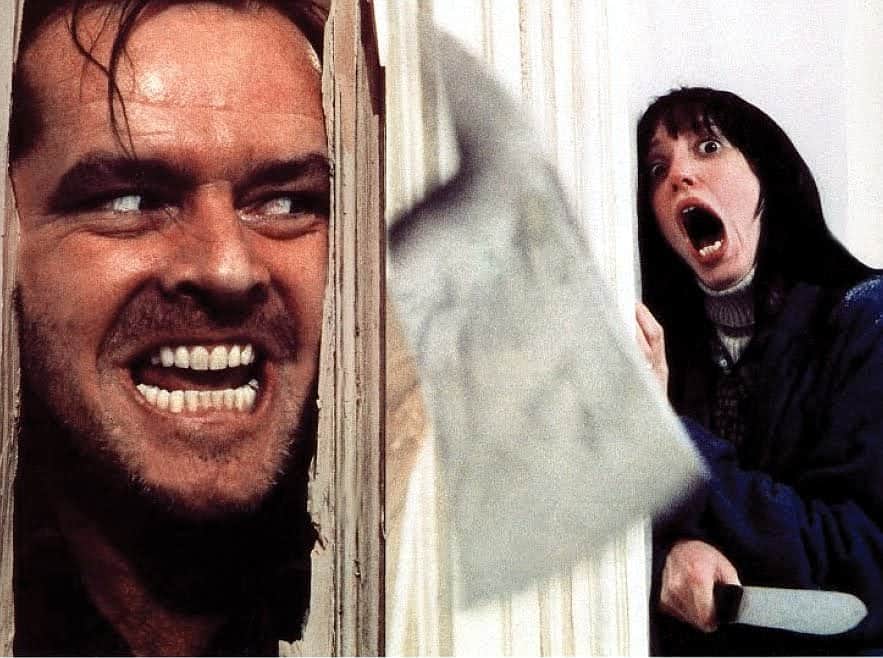In adapting “The Shining” in 1980, Stanley Kubrick didn’t just craft a horror story; he created an enigma brimming with symbolism. The plot unfolds in the isolated Overlook Hotel, plunging viewers into a mystery-laden atmosphere, further intensified by Jack Nicholson’s performance.
Kubrick’s Mysterious Glow in “The Shining”
The story initially introduces us to Jack Torrance, a writer seeking inspiration. He moves to the secluded Overlook Hotel with his family. However, the movie quickly dives into a narrative filled with mystery and terror, far beyond what appears on the surface.
Jack Nicholson masterfully portrays Jack, whose descent into madness progressively intensifies. Meanwhile, the psychic abilities of his son Danny and the dark secrets of the hotel add layers of complexity to the narrative. Since its release, “The Shining” has captured the audience’s imagination, sparking numerous debates and theories about the hidden messages and intricate symbolism Kubrick wove into the film.
Beyond a mere horror story, “The Shining” stands as a work rich in mysteries and hidden meanings, inviting new generations to explore and reinterpret its puzzles. This film not only highlights Kubrick’s genius as a filmmaker but also reminds us that certain works can keep us probing and seeking answers long after the cinema lights go out.
Deciphering Kubrick’s Code
At the heart of “The Shining,” theories extend beyond mere psychological terror. Fans and experts alike have devoted countless hours to analyzing the potential messages Stanley Kubrick, known for his meticulousness and symbolic use, embedded in the film.
Among the most debated theories is the allusion to the genocide of Native Americans, a concept derived from the Overlook Hotel’s construction on an indigenous cemetery. Additionally, references to the Holocaust are suggested through the repeated use of the number 42, linked to the year the Nazi “Final Solution” was planned.
Remarkably, another theory connects “The Shining” to the space race, proposing that Kubrick used the film to confess his role in the supposed Apollo 11 moon landing hoax. Elements like Danny’s sweater with the Apollo 11 emblem and the hotel’s carpet design, reminiscent of a launch pad, fuel this speculation.
Proponents of these theories bolster their arguments with Kubrick’s obsession with detail. For instance, changing the color of the Torrance family’s car from red to yellow is interpreted as a nod to the Star of David, worn by Jews during the Holocaust.
Similarly, the presence of Calumet baking powder cans, a brand name meaning “peace pipe” in Native American cultures, in the hotel’s pantry is seen as a reference to the oppression of these people.
These and other scattered elements throughout the film offer fertile ground for interpretation. “The Shining” thus becomes an invitation to exploration and debate, far beyond its horror facade. Kubrick’s work not only demonstrates his brilliance as a filmmaker but also showcases the power of cinema to provoke deep reflection and dialogue.
Between Speculation and Reality
The fascination with “The Shining” transcends mere interpretations. The depth and detail with which fans and experts have explored this film are impressive. A prime example is the documentary “Room 237,” which reveals the lengths some have gone to understand the movie’s complexity.
These investigations reveal a wide array of theories, demonstrating a deep appreciation for Kubrick’s cinematic art. The passion with which these interpretations are analyzed reflects a collective desire to find meaning and connection beyond mere entertainment.
Whether Kubrick intentionally planted hidden messages in “The Shining” remains a topic of debate. However, this discussion is a tribute to his skill as a filmmaker, a virtuoso in creating works that challenge our perception and encourage personal interpretation.
In this light, “The Shining” can be seen both as a tale of psychological disintegration and a canvas for exploring much deeper and universal themes.
The interpretation of “The Shining” varies widely among viewers, highlighting the film’s richness and ability to resonate on multiple levels: the intentional ambiguity and symbolic complexity invite ongoing exploration.
This ensures that “The Shining” remains relevant and a subject of analysis in the future, highlighting not only Kubrick’s genius as a director but also the power of cinema to connect with viewers in a deeply personal and meaningful way.
The Enduring Fascination with “The Shining”
The attraction of “The Shining” across generations is undeniable. This enduring interest is due not only to the curiosity sparked by hidden interpretations but also to Stanley Kubrick’s unmatched talent as a director.
“The Shining” remains a topic of intense conversation, analysis, and debate, owing to both its explicit content and subtle insinuations.
The ability of “The Shining” to foster such discussion attests to cinematography as a powerful exploration tool. This work delves into the depths of the human psyche and history, as well as conspiracy theories, maintaining its status as an iconic piece of the horror genre.
Beyond theories and speculation, what truly ensures “The Shining’s” lasting place in the collective imagination is its narrative quality and technical execution. Kubrick, with his characteristic perfectionism and attention to detail, created an atmosphere of tension and terror that remains effective decades after its premiere.
His skill in intertwining symbolism with universal themes, while maintaining a cohesive narrative, marks “The Shining” as a masterpiece.
In summary, “The Shining” is not just a movie about a man losing his sanity. It’s a rich and complex canvas that invites every viewer to project their theories, fears, and inquiries. Kubrick’s work continues to challenge us to look beyond the obvious, to question and seek deeper meanings.





